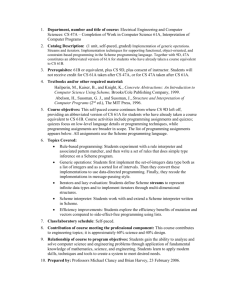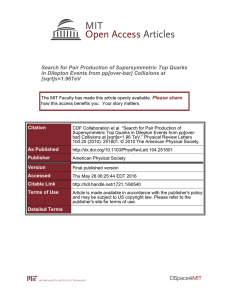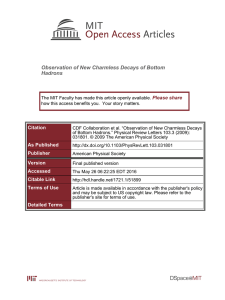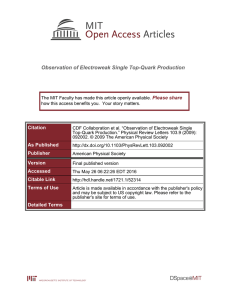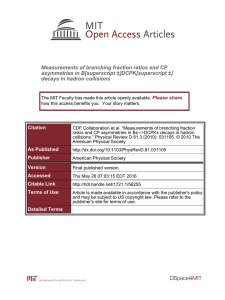Precision Measurement of the X(3872) Mass in J/ psi pi + pi - Decays Please share
advertisement
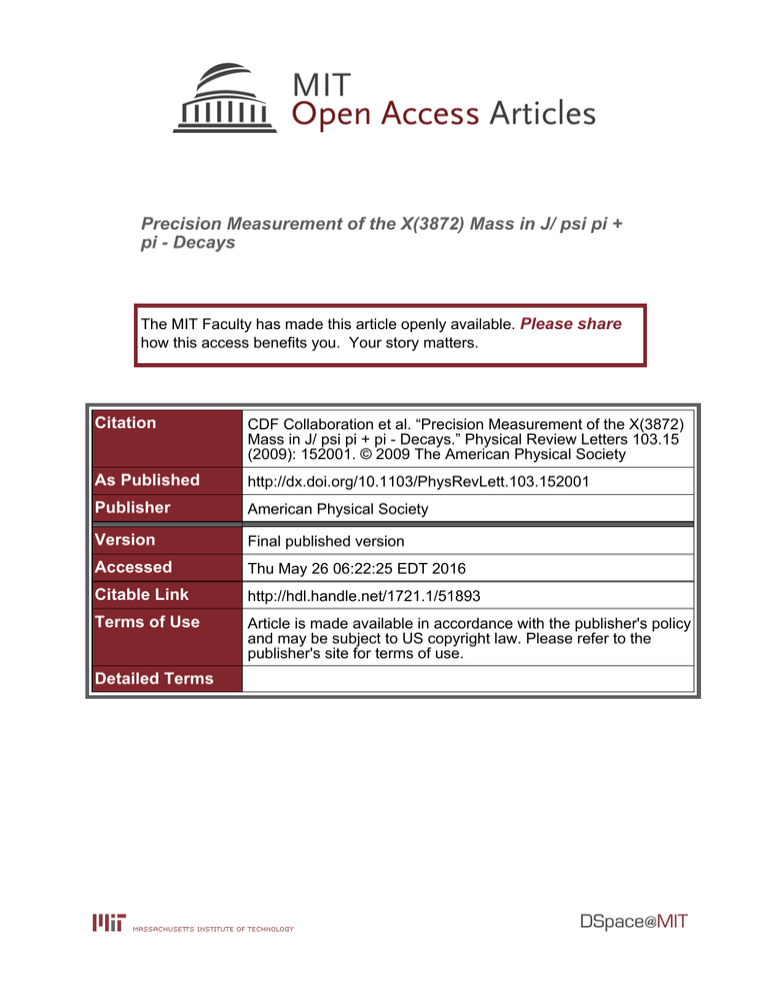
Precision Measurement of the X(3872) Mass in J/ psi pi + pi - Decays The MIT Faculty has made this article openly available. Please share how this access benefits you. Your story matters. Citation CDF Collaboration et al. “Precision Measurement of the X(3872) Mass in J/ psi pi + pi - Decays.” Physical Review Letters 103.15 (2009): 152001. © 2009 The American Physical Society As Published http://dx.doi.org/10.1103/PhysRevLett.103.152001 Publisher American Physical Society Version Final published version Accessed Thu May 26 06:22:25 EDT 2016 Citable Link http://hdl.handle.net/1721.1/51893 Terms of Use Article is made available in accordance with the publisher's policy and may be subject to US copyright law. Please refer to the publisher's site for terms of use. Detailed Terms PRL 103, 152001 (2009) PHYSICAL REVIEW LETTERS week ending 9 OCTOBER 2009 Precision Measurement of the Xð3872Þ Mass in J= c þ Decays T. Aaltonen,24 J. Adelman,14 T. Akimoto,56 B. Álvarez González,12,u S. Amerio,44b,44a D. Amidei,35 A. Anastassov,39 A. Annovi,20 J. Antos,15 G. Apollinari,18 A. Apresyan,49 T. Arisawa,58 A. Artikov,16 W. Ashmanskas,18 A. Attal,4 A. Aurisano,54 F. Azfar,43 W. Badgett,18 A. Barbaro-Galtieri,29 V. E. Barnes,49 B. A. Barnett,26 P. Barria,47c,47a P. Bartos,15 V. Bartsch,31 G. Bauer,33 P.-H. Beauchemin,34 F. Bedeschi,47a D. Beecher,31 S. Behari,26 G. Bellettini,47b,47a J. Bellinger,60 D. Benjamin,17 A. Beretvas,18 J. Beringer,29 A. Bhatti,51 M. Binkley,18 D. Bisello,44b,44a I. Bizjak,31,z R. E. Blair,2 C. Blocker,7 B. Blumenfeld,26 A. Bocci,17 A. Bodek,50 V. Boisvert,50 G. Bolla,49 D. Bortoletto,49 J. Boudreau,48 A. Boveia,11 B. Brau,11,b A. Bridgeman,25 L. Brigliadori,6b,6a C. Bromberg,36 E. Brubaker,14 J. Budagov,16 H. S. Budd,50 S. Budd,25 S. Burke,18 K. Burkett,18 G. Busetto,44b,44a P. Bussey,22 A. Buzatu,34 K. L. Byrum,2 S. Cabrera,17,w C. Calancha,32 M. Campanelli,36 M. Campbell,35 F. Canelli,14,18 A. Canepa,46 B. Carls,25 D. Carlsmith,60 R. Carosi,47a S. Carrillo,19,o S. Carron,34 B. Casal,12 M. Casarsa,18 A. Castro,6b,6a P. Catastini,47c,47a D. Cauz,55b,55a V. Cavaliere,47c,47a M. Cavalli-Sforza,4 A. Cerri,29 L. Cerrito,31,q S. H. Chang,28 Y. C. Chen,1 M. Chertok,8 G. Chiarelli,47a G. Chlachidze,18 F. Chlebana,18 K. Cho,28 D. Chokheli,16 J. P. Chou,23 G. Choudalakis,33 S. H. Chuang,53 K. Chung,18,p W. H. Chung,60 Y. S. Chung,50 T. Chwalek,27 C. I. Ciobanu,45 M. A. Ciocci,47c,47a A. Clark,21 D. Clark,7 G. Compostella,44a M. E. Convery,18 J. Conway,8 M. Cordelli,20 G. Cortiana,44a C. A. Cox,8 D. J. Cox,8 F. Crescioli,47b,47a C. Cuenca Almenar,8,w J. Cuevas,12,u R. Culbertson,18 J. C. Cully,35 D. Dagenhart,18 M. Datta,18 T. Davies,22 P. de Barbaro,50 S. De Cecco,52a A. Deisher,29 G. De Lorenzo,4 M. Dell’Orso,47b,47a C. Deluca,4 L. Demortier,51 J. Deng,17 M. Deninno,6a P. F. Derwent,18 A. Di Canto,47b G. P. di Giovanni,45 C. Dionisi,52b,52a B. Di Ruzza,55b,55a J. R. Dittmann,5 M. D’Onofrio,4 S. Donati,47b,47a P. Dong,9 J. Donini,44a T. Dorigo,44a S. Dube,53 J. Efron,40 A. Elagin,54 R. Erbacher,8 D. Errede,25 S. Errede,25 R. Eusebi,18 H. C. Fang,29 S. Farrington,43 W. T. Fedorko,14 R. G. Feild,61 M. Feindt,27 J. P. Fernandez,32 C. Ferrazza,47d,47a R. Field,19 G. Flanagan,49 R. Forrest,8 M. J. Frank,5 M. Franklin,23 J. C. Freeman,18 I. Furic,19 M. Gallinaro,52a J. Galyardt,13 F. Garberson,11 J. E. Garcia,21 A. F. Garfinkel,49 P. Garosi,47c,47a K. Genser,18 H. Gerberich,25 D. Gerdes,35 A. Gessler,27 S. Giagu,52b,52a V. Giakoumopoulou,3 P. Giannetti,47a K. Gibson,48 J. L. Gimmell,50 C. M. Ginsburg,18 N. Giokaris,3 M. Giordani,55b,55a P. Giromini,20 M. Giunta,47a G. Giurgiu,26 V. Glagolev,16 D. Glenzinski,18 M. Gold,38 N. Goldschmidt,19 A. Golossanov,18 G. Gomez,12 G. Gomez-Ceballos,33 M. Goncharov,33 O. González,32 I. Gorelov,38 A. T. Goshaw,17 K. Goulianos,51 A. Gresele,44b,44a S. Grinstein,23 C. Grosso-Pilcher,14 R. C. Group,18 U. Grundler,25 J. Guimaraes da Costa,23 Z. Gunay-Unalan,36 C. Haber,29 K. Hahn,33 S. R. Hahn,18 E. Halkiadakis,53 B.-Y. Han,50 J. Y. Han,50 F. Happacher,20 K. Hara,56 D. Hare,53 M. Hare,57 S. Harper,43 R. F. Harr,59 R. M. Harris,18 M. Hartz,48 K. Hatakeyama,51 C. Hays,43 M. Heck,27 A. Heijboer,46 J. Heinrich,46 C. Henderson,33 M. Herndon,60 J. Heuser,27 S. Hewamanage,5 D. Hidas,17 C. S. Hill,11,d D. Hirschbuehl,27 A. Hocker,18 S. Hou,1 M. Houlden,30 S.-C. Hsu,29 B. T. Huffman,43 R. E. Hughes,40 U. Husemann,61 M. Hussein,36 J. Huston,36 J. Incandela,11 G. Introzzi,47a M. Iori,52b,52a A. Ivanov,8 E. James,18 D. Jang,13 B. Jayatilaka,17 E. J. Jeon,28 M. K. Jha,6a S. Jindariani,18 W. Johnson,8 M. Jones,49 K. K. Joo,28 S. Y. Jun,13 J. E. Jung,28 T. R. Junk,18 T. Kamon,54 D. Kar,19 P. E. Karchin,59 Y. Kato,42,n R. Kephart,18 W. Ketchum,14 J. Keung,46 V. Khotilovich,54 B. Kilminster,18 D. H. Kim,28 H. S. Kim,28 H. W. Kim,28 J. E. Kim,28 M. J. Kim,20 S. B. Kim,28 S. H. Kim,56 Y. K. Kim,14 N. Kimura,56 L. Kirsch,7 S. Klimenko,19 B. Knuteson,33 B. R. Ko,17 K. Kondo,58 D. J. Kong,28 J. Konigsberg,19 A. Korytov,19 A. V. Kotwal,17 M. Kreps,27 J. Kroll,46 D. Krop,14 N. Krumnack,5 M. Kruse,17 V. Krutelyov,11 T. Kubo,56 T. Kuhr,27 N. P. Kulkarni,59 M. Kurata,56 S. Kwang,14 A. T. Laasanen,49 S. Lami,47a S. Lammel,18 M. Lancaster,31 R. L. Lander,8 K. Lannon,40,t A. Lath,53 G. Latino,47c I. Lazzizzera,44b T. LeCompte,2 E. Lee,54 H. S. Lee,14 S. W. Lee,54,v S. Leone,47a J. D. Lewis,18 C.-S. Lin,29 J. Linacre,43 M. Lindgren,18 E. Lipeles,46 A. Lister,8 D. O. Litvintsev,18 C. Liu,48 T. Liu,18 N. S. Lockyer,46 A. Loginov,61 M. Loreti,44b,44a L. Lovas,15 D. Lucchesi,44b,44a C. Luci,52b,52a J. Lueck,27 P. Lujan,29 P. Lukens,18 G. Lungu,51 L. Lyons,43 J. Lys,29 R. Lysak,15 D. MacQueen,34 R. Madrak,18 K. Maeshima,18 K. Makhoul,33 T. Maki,24 P. Maksimovic,26 S. Malde,43 S. Malik,31 G. Manca,30,f A. Manousakis-Katsikakis,3 F. Margaroli,49 C. Marino,27 C. P. Marino,25 A. Martin,61 V. Martin,22,l M. Martı́nez,4 R. Martı́nez-Balları́n,32 T. Maruyama,56 P. Mastrandrea,52a T. Masubuchi,56 M. Mathis,26 M. E. Mattson,59 P. Mazzanti,6a K. S. McFarland,50 P. McIntyre,54 R. McNulty,30,k A. Mehta,30 P. Mehtala,24 A. Menzione,47a P. Merkel,49 C. Mesropian,51 T. Miao,18 N. Miladinovic,7 R. Miller,36 C. Mills,23 M. Milnik,27 A. Mitra,1 G. Mitselmakher,19 H. Miyake,56 N. Moggi,6a M. N. Mondragon,18,o C. S. Moon,28 R. Moore,18 M. J. Morello,47a J. Morlock,27 P. Movilla Fernandez,18 J. Mülmenstädt,29 A. Mukherjee,18 Th. Muller,27 R. Mumford,26 P. Murat,18 M. Mussini,6b,6a J. Nachtman,18,p Y. Nagai,56 A. Nagano,56 J. Naganoma,56 K. Nakamura,56 0031-9007=09=103(15)=152001(8) 152001-1 Ó 2009 The American Physical Society PRL 103, 152001 (2009) PHYSICAL REVIEW LETTERS week ending 9 OCTOBER 2009 I. Nakano,41 A. Napier,57 V. Necula,17 J. Nett,60 C. Neu,46,x M. S. Neubauer,25 S. Neubauer,27 J. Nielsen,29,h L. Nodulman,2 M. Norman,10 O. Norniella,25 E. Nurse,31 L. Oakes,43 S. H. Oh,17 Y. D. Oh,28 I. Oksuzian,19 T. Okusawa,42 R. Orava,24 K. Osterberg,24 S. Pagan Griso,44b,44a C. Pagliarone,55a E. Palencia,18 V. Papadimitriou,18 A. Papaikonomou,27 A. A. Paramonov,14 B. Parks,40 S. Pashapour,34 J. Patrick,18 G. Pauletta,55b,55a M. Paulini,13 C. Paus,33 T. Peiffer,27 D. E. Pellett,8 A. Penzo,55a T. J. Phillips,17 G. Piacentino,47a E. Pianori,46 L. Pinera,19 K. Pitts,25 C. Plager,9 L. Pondrom,60 O. Poukhov,16,a N. Pounder,43 F. Prakoshyn,16 A. Pronko,18 J. Proudfoot,2 F. Ptohos,18,j E. Pueschel,13 G. Punzi,47b,47a J. Pursley,60 J. Rademacker,43,d A. Rahaman,48 V. Ramakrishnan,60 N. Ranjan,49 I. Redondo,32 P. Renton,43 M. Renz,27 M. Rescigno,52a S. Richter,27 F. Rimondi,6b,6a L. Ristori,47a A. Robson,22 T. Rodrigo,12 T. Rodriguez,46 E. Rogers,25 S. Rolli,57 R. Roser,18 M. Rossi,55a R. Rossin,11 P. Roy,34 A. Ruiz,12 J. Russ,13 V. Rusu,18 B. Rutherford,18 H. Saarikko,24 A. Safonov,54 W. K. Sakumoto,50 O. Saltó,4 L. Santi,55b,55a S. Sarkar,52b,52a L. Sartori,47a K. Sato,18 A. Savoy-Navarro,45 P. Schlabach,18 A. Schmidt,27 E. E. Schmidt,18 M. A. Schmidt,14 M. P. Schmidt,61,a M. Schmitt,39 T. Schwarz,8 L. Scodellaro,12 A. Scribano,47c,47a F. Scuri,47a A. Sedov,49 S. Seidel,38 Y. Seiya,42 A. Semenov,16 L. Sexton-Kennedy,18 F. Sforza,47b,47a A. Sfyrla,25 S. Z. Shalhout,59 T. Shears,30 P. F. Shepard,48 M. Shimojima,56,s S. Shiraishi,14 M. Shochet,14 Y. Shon,60 I. Shreyber,37 P. Sinervo,34 A. Sisakyan,16 A. J. Slaughter,18 J. Slaunwhite,40 K. Sliwa,57 J. R. Smith,8 F. D. Snider,18 R. Snihur,34 A. Soha,8 S. Somalwar,53 V. Sorin,36 T. Spreitzer,34 P. Squillacioti,47c,47a M. Stanitzki,61 R. St. Denis,22 B. Stelzer,34 O. Stelzer-Chilton,34 D. Stentz,39 J. Strologas,38 G. L. Strycker,35 J. S. Suh,28 A. Sukhanov,19 I. Suslov,16 T. Suzuki,56 A. Taffard,25,g R. Takashima,41 Y. Takeuchi,56 R. Tanaka,41 M. Tecchio,35 P. K. Teng,1 K. Terashi,51 J. Thom,18,i A. S. Thompson,22 G. A. Thompson,25 E. Thomson,46 P. Tipton,61 P. Ttito-Guzmán,32 S. Tkaczyk,18 D. Toback,54 S. Tokar,15 K. Tollefson,36 T. Tomura,56 D. Tonelli,18 S. Torre,20 D. Torretta,18 P. Totaro,55b,55a S. Tourneur,45 M. Trovato,47d,47a S.-Y. Tsai,1 Y. Tu,46 N. Turini,47c,47a F. Ukegawa,56 S. Vallecorsa,21 N. van Remortel,24,c A. Varganov,35 E. Vataga,47d,47a F. Vázquez,19,o G. Velev,18 C. Vellidis,3 M. Vidal,32 R. Vidal,18 I. Vila,12 R. Vilar,12 T. Vine,31 M. Vogel,38 I. Volobouev,29,v G. Volpi,47b,47a P. Wagner,46 R. G. Wagner,2 R. L. Wagner,18 W. Wagner,27,y J. Wagner-Kuhr,27 T. Wakisaka,42 R. Wallny,9 S. M. Wang,1 A. Warburton,34 D. Waters,31 M. Weinberger,54 J. Weinelt,27 W. C. Wester III,18 B. Whitehouse,57 D. Whiteson,46,g A. B. Wicklund,2 E. Wicklund,18 S. Wilbur,14 G. Williams,34 H. H. Williams,46 P. Wilson,18 B. L. Winer,40 P. Wittich,18,i S. Wolbers,18 C. Wolfe,14 T. Wright,35 X. Wu,21 F. Würthwein,10 S. Xie,33 A. Yagil,10 K. Yamamoto,42 J. Yamaoka,17 U. K. Yang,14,r Y. C. Yang,28 W. M. Yao,29 G. P. Yeh,18 K. Yi,18,p J. Yoh,18 K. Yorita,58 T. Yoshida,42,m G. B. Yu,50 I. Yu,28 S. S. Yu,18 J. C. Yun,18 L. Zanello,52b,52a A. Zanetti,55a X. Zhang,25 Y. Zheng,9,e and S. Zucchelli6b,6a (CDF Collaboration) 1 Institute of Physics, Academia Sinica, Taipei, Taiwan 11529, Republic of China 2 Argonne National Laboratory, Argonne, Illinois 60439 3 University of Athens, 157 71 Athens, Greece 4 Institut de Fisica d’Altes Energies, Universitat Autonoma de Barcelona, E-08193, Bellaterra (Barcelona), Spain 5 Baylor University, Waco, Texas 76798, USA 6a Istituto Nazionale di Fisica Nucleare Bologna, I-40127 Bologna, Italy 6b University of Bologna, I-40127 Bologna, Italy 7 Brandeis University, Waltham, Massachusetts 02254, USA 8 University of California, Davis, Davis, California 95616, USA 9 University of California, Los Angeles, Los Angeles, California 90024, USA 10 University of California, San Diego, La Jolla, California 92093, USA 11 University of California, Santa Barbara, Santa Barbara, California 93106, USA 12 Instituto de Fisica de Cantabria, CSIC-University of Cantabria, 39005 Santander, Spain 13 Carnegie Mellon University, Pittsburgh, Pennsylvania 15213, USA 14 Enrico Fermi Institute, University of Chicago, Chicago, Illinois 60637, USA 15 Comenius University, 842 48 Bratislava, Slovakia; Institute of Experimental Physics, 040 01 Kosice, Slovakia 16 Joint Institute for Nuclear Research, RU-141980 Dubna, Russia 17 Duke University, Durham, North Carolina 27708, USA 18 Fermi National Accelerator Laboratory, Batavia, Illinois 60510, USA 19 University of Florida, Gainesville, Florida 32611, USA 20 Laboratori Nazionali di Frascati, Istituto Nazionale di Fisica Nucleare, I-00044 Frascati, Italy 21 University of Geneva, CH-1211 Geneva 4, Switzerland 22 Glasgow University, Glasgow G12 8QQ, United Kingdom 23 Harvard University, Cambridge, Massachusetts 02138, USA 152001-2 PRL 103, 152001 (2009) PHYSICAL REVIEW LETTERS week ending 9 OCTOBER 2009 24 Division of High Energy Physics, Department of Physics, University of Helsinki and Helsinki Institute of Physics, FIN-00014, Helsinki, Finland 25 University of Illinois, Urbana, Illinois 61801, USA 26 The Johns Hopkins University, Baltimore, Maryland 21218, USA 27 Institut für Experimentelle Kernphysik, Universität Karlsruhe, 76128 Karlsruhe, Germany 28 Center for High Energy Physics: Kyungpook National University, Daegu 702-701, Korea; Seoul National University, Seoul 151-742, Korea; Sungkyunkwan University, Suwon 440-746, Korea; Korea Institute of Science and Technology Information, Daejeon 305-806, Korea; Chonnam National University, Gwangju 500-757, Korea; Chonbuk National University, Jeonju 561-756, Korea 29 Ernest Orlando Lawrence Berkeley National Laboratory, Berkeley, California 94720, USA 30 University of Liverpool, Liverpool L69 7ZE, United Kingdom 31 University College London, London WC1E 6BT, United Kingdom 32 Centro de Investigaciones Energeticas Medioambientales y Tecnologicas, E-28040 Madrid, Spain 33 Massachusetts Institute of Technology, Cambridge, Massachusetts 02139, USA 34 Institute of Particle Physics: McGill University, Montréal, Québec, Canada H3A 2T8; Simon Fraser University, Burnaby, British Columbia, Canada V5A 1S6; University of Toronto, Toronto, Ontario, Canada M5S 1A7; and TRIUMF, Vancouver, British Columbia, Canada V6T 2A3 35 University of Michigan, Ann Arbor, Michigan 48109, USA 36 Michigan State University, East Lansing, Michigan 48824, USA 37 Institution for Theoretical and Experimental Physics, ITEP, Moscow 117259, Russia 38 University of New Mexico, Albuquerque, New Mexico 87131, USA 39 Northwestern University, Evanston, Illinois 60208, USA 40 The Ohio State University, Columbus, Ohio 43210, USA 41 Okayama University, Okayama 700-8530, Japan 42 Osaka City University, Osaka 588, Japan 43 University of Oxford, Oxford OX1 3RH, United Kingdom 44a Istituto Nazionale di Fisica Nucleare, Sezione di Padova-Trento, I-35131 Padova, Italy 44b University of Padova, I-35131 Padova, Italy 45 LPNHE, Universite Pierre et Marie Curie/IN2P3-CNRS, UMR7585, Paris, F-75252 France 46 University of Pennsylvania, Philadelphia, Pennsylvania 19104, USA 47a Istituto Nazionale di Fisica Nucleare Pisa, I-56127 Pisa, Italy 47b University of Pisa, I-56127 Pisa, Italy 47c University of Siena, I-56127 Pisa, Italy 47d Scuola Normale Superiore, I-56127 Pisa, Italy 48 University of Pittsburgh, Pittsburgh, Pennsylvania 15260, USA 49 Purdue University, West Lafayette, Indiana 47907, USA 50 University of Rochester, Rochester, New York 14627, USA 51 The Rockefeller University, New York, New York 10021, USA 52a Istituto Nazionale di Fisica Nucleare, Sezione di Roma 1, I-00185 Roma, Italy 52b Sapienza Università di Roma, I-00185 Roma, Italy 53 Rutgers University, Piscataway, New Jersey 08855, USA 54 Texas A&M University, College Station, Texas 77843, USA 55a Istituto Nazionale di Fisica Nucleare Trieste/Udine, I-34100 Trieste, Italy 55b University of Trieste/Udine, I-33100 Udine, Italy 56 University of Tsukuba, Tsukuba, Ibaraki 305, Japan 57 Tufts University, Medford, Massachusetts 02155, USA 58 Waseda University, Tokyo 169, Japan 59 Wayne State University, Detroit, Michigan 48201, USA 60 University of Wisconsin, Madison, Wisconsin 5370, USA6 61 Yale University, New Haven, Connecticut 06520, USA (Received 29 June 2009; published 5 October 2009) We present an analysis of the mass of the Xð3872Þ reconstructed via its decay to J= c þ using pffiffiffi 2:4 fb1 of integrated luminosity from pp collisions at s ¼ 1:96 TeV, collected with the CDF II detector at the Fermilab Tevatron. The possible existence of two nearby mass states is investigated. Within the limits of our experimental resolution the data are consistent with a single state, and having no evidence for two states we set upper limits on the mass difference between two hypothetical states for different assumed ratios of contributions to the observed peak. For equal contributions, the 95% confidence level 152001-3 PRL 103, 152001 (2009) PHYSICAL REVIEW LETTERS week ending 9 OCTOBER 2009 upper limit on the mass difference is 3:6 MeV=c2 . Under the single-state model the Xð3872Þ mass is measured to be 3871:61 0:16ðstatÞ 0:19ðsystÞ MeV=c2 , which is the most precise determination to date. DOI: 10.1103/PhysRevLett.103.152001 PACS numbers: 14.40.Gx, 12.39.Mk, 13.25.Gv The discovery of the Xð3872Þ [1,2] and many additional unexpected states [3] has revived general interest in spectroscopy in the charmonium mass region. Initial attempts to explain the Xð3872Þ as a conventional bound state of a c quark and an anti–c quark have shortcomings [4] which triggered the development of unconventional explanations. Two popular models are a molecular state composed of D0 and D 0 mesons [5,6], and a four-quark state [7]. In an effort to resolve the nature of Xð3872Þ, several of its properties have been measured. The first determinations of its mass [1,2,8,9] resulted in values very close to the D0 D 0 mass threshold. The observed width in these measurements was compatible with zero. Studies of the Xð3872Þ production properties in pp collisions [8,10] suggest that the production mechanisms are similar to those for the c ð2SÞ charmonium state. Several measurements constrained the quantum numbers spin (J), parity (P), and charge-conjugation parity (C) of the Xð3872Þ. These include evidence for the decay modes Xð3872Þ ! J= c , J= c !, and c ð2SÞ [11], and a measurement of the mass distribution of the dipions from the Xð3872Þ ! J= c þ decay [12]. These measurements indicate an even C parity. A subsequent angular analysis constrained the quantum numbers to only two possibilities, J PC ¼ 1þþ or 2þ [13]. A possible further decay mode of the Xð3872Þ was identified as a peak near threshold in the D0 D 0 0 invariant mass spectrum [14] with a mean mass more than 3 MeV=c2 above measurements in the J= c þ mode. Despite efforts on both the experimental and theoretical sides, the nature of the Xð3872Þ still remains an unresolved puzzle. A measurement of the Xð3872Þ mass with increased precision can provide crucial information for understanding its nature. Under the hypothesis of a molecular state the mass of the Xð3872Þ has to be lower than the sum of the D0 and D 0 masses. The four-quark state hypothesis predicts the existence of two distinct particles that differ by the light-quark content bound to the cc quarks. These two particles should have slightly different masses, and the model of Maiani et al. [7] predicts a mass difference at the level of 8 3 MeV=c2 . Recent measurements of the difference between the Xð3872Þ mass in Bþ ! Xð3872ÞKþ and B0 ! Xð3872ÞK0 decays [15,16] disfavor this model under the hypothesis that one state is dominantly produced in Bþ decays and the other one in B0 decays. In this Letter we report a study of the mass of the Xð3872Þ resonance produced in pp collisions. We consider the conjecture that the structure observed in our data is composed of two different states with distinct masses; but failing to discern any evidence for this possibility we set an upper limit on the mass difference between two hypothetical states. In light of this result we perform a precision measurement of the Xð3872Þ mass, the main result of this Letter. The data were collected by the CDF II detector at the Fermilab Tevatron pp collider between February 2002 and August 2007, and correspond to an integrated luminosity of 2:4 fb1 . The CDF II detector [17] consists of a magnetic spectrometer surrounded by electromagnetic and hadronic calorimeters and muon detectors. The tracking system is immersed in a 1.4 T axial magnetic field and is composed of a silicon microstrip detector [18] surrounded by an open-cell drift chamber (COT) [19]. It extends out to a radius of 138 cm with up to 96 position measurements in the COT, and achieves a transverse momentum resolution of ðpT Þ=pT 0:15%pT =ðGeV=cÞ. We detect muons in planes of multiwire drift chambers and scintillators [20] in the pseudorapidity range jj 1:0. Events with J= c ! þ decays are recorded using a dimuon trigger, which requires two oppositely charged COT tracks matched to muon chamber track segments. The reconstructed invariant mass of a dimuon pair is required to be between 2.7 and 4:0 GeV=c2 . To reconstruct Xð3872Þ candidates we first build J= c candidates by combining pairs of oppositely charged muon candidates with a transverse momentum, pT , larger than 1:5 GeV=c. The Xð3872Þ candidates are formed by combining J= c candidates in the invariant mass range from 2.95 to 3:25 GeV=c2 with pairs of oppositely charged tracks, each with pT > 0:4 GeV=c and assigned the pion mass. We require that all four tracks have at least 10 COT and 2 silicon hits. For the resulting Xð3872Þ candidates with pT > 3:5 GeV=c, we perform a kinematic fit in which the tracks are constrained to originate from a common vertex and the dimuon invariant mass is constrained to the world average J= c mass [21]. Candidates having a kinematic fit of good quality are selected in a broad invariant mass range containing, in addition to Xð3872Þ candidates, also c ð2SÞ candidates that decay to the same final state. The c ð2SÞ serves as a valuable control sample. Several discriminating quantities are combined by a neural network into a single selection variable. The individual quantities are transformed such that linear dependences on the invariant mass are removed. The most important inputs to the neural network are the Q value of 152001-4 week ending 9 OCTOBER 2009 PHYSICAL REVIEW LETTERS 4500 4000 3500 3000 2500 Candidates per 1.25 MeV/c2 Candidates per 2.5 MeV/c2 the decay, defined as Q ¼ mJ= c þ mþ mJ= c , the transverse momenta of the two pions, the quality of the kinematic fit of the Xð3872Þ candidate, and muon identification quantities. The offline muon identification is based on the matching of tracks found in the tracking system to track segments in the muon system and on the energy deposited in the calorimeter by the muoncandidates. For the training of the neural network, a background sample is extracted from data, selecting events in regions of the J= c þ mass away from the Xð3872Þ and c ð2SÞ signals, mainly consisting of J= c particles combined with two random tracks. For the signal sample we use simulated Xð3872Þ events. In the simulation we generate a single Xð3872Þ per event using the momentum distribution of the c ð2SÞ, which is then decayed using the EVTGEN package [22]. Each event is then passed through a detector simulation based on the GEANT3 package [23] and a trigger simulation, and is reconstructed with the same code as for real data. The simulation is in good agreement with the data as verified with several kinematic quantities. The final selection places a requirement on the neural network output and the number of candidates per event. Using wrong-sign candidates, where the two pion candidates have the same charge, we verify that the selection does not create an artificial excess in the mass spectrum. The invariant mass distribution of the selected candidates in the Xð3872Þ mass region is shown in Fig. 1. The sample contains about 6000 Xð3872Þ signal events. Before we perform a mass measurement, we test whether the signal is consistent with a single state or we have evidence for more than one state. In the test we perform a binned maximum-likelihood fit to the mass distribution in data, where we describe the combinatorial background by a second-order polynomial, and the signal by a nonrelativistic Breit-Wigner function convolved with a resolution function determined from simulated events and parametrized by the sum of two Gaussians. The core Gaussian, with a width of 3:2 MeV=c2 , accounts for two thirds of the resolution function; the second Gaussian has about twice the width. In the fit we fix the width of the Breit-Wigner function to ¼ 1:34 MeV=c2 , our average of the widths measured in J= c þ decays [1,15]. The uncertainty on of 0:64 MeV=c2 is taken into account in the hypothesis test described below. As a test statistic we introduce a factor t that scales the intrinsic and resolution widths of the signal shape. The value of t determined by the fit to the data is then compared to the distribution of t from an ensemble of simulated experiments that assume a single state. Based on this comparison the consistency of the data with the single-state hypothesis is evaluated. The pseudoexperiments are generated using the same fit model as in data. As several quantities are known only with limited precision, we vary those in the sample generation according to their uncertainties. The varied parameters include background shape parameters, the number of signal and 2000 1500 1000 500 data-fit PRL 103, 152001 (2009) 2200 2000 1800 1600 1400 3.85 3.86 3.87 3.88 3.89 200 0 -200 3.75 3.80 3.85 3.90 3.95 4.00 J/ψπ+π- Mass (GeV/c2) FIG. 1 (color online). Invariant mass distribution of the Xð3872Þ candidates. The points show the data distribution, the full line is the projection of the unbinned maximum-likelihood fit, and the dashed line corresponds to the background part of the fit. The inset shows an enlargement of the region around the Xð3872Þ peak. Residuals of the data with respect to the fit are displayed below the mass plot. background events, the width of the Breit-Wigner function, and the overall width of the resolution function. From a comparison of the c ð2SÞ signal in the data to that of simulated events we observe that the simulation underestimates the resolution by about 5%. The samples were generated with a resolution corrected for this discrepancy. From data we obtain a width scale parameter value of t ¼ 1:052. In Fig. 2 we show a comparison of the fitted scale parameter to the distribution obtained from simulated experiments assuming a single state. We conclude that the data are fully consistent with a single state. In the absence of evidence for two distinct states we set an upper limit on the possible mass difference between two hypothetical states. As a test statistic we use the width scale t, which is compared to expectations from samples simulated with different mass splittings. We assume that both states have the same mass shape and do not interfere. We derive upper limits as a function of the fraction f1 of the lower lying state to the total observed signal. The resulting 90% and 95% C.L. upper limits are shown in Fig. 3. For an equal mixture of the two contributing states, the limits are m < 3:2 MeV=c2 and m < 3:6 MeV=c2 at 90% and 95% confidence levels, respectively. This result is complementary to other measurements [15,16] in that it does not rely on assumptions about the production of the two hypothetical states in Bþ versus B0 decays, but depends on f1 . 152001-5 Experiments per 0.012 PRL 103, 152001 (2009) PHYSICAL REVIEW LETTERS 1800 Measured Value 1600 1400 1200 1000 800 600 400 200 0 0.8 1.0 1.2 1.4 Width Scale t FIG. 2 (color online). Distribution of the width scale t for generated experiments using the single-state hypothesis (histogram). Also shown is the measured value from data (vertical line). ∆m (MeV/c2) Lacking any indication of dual states we proceed to extract the mass of the Xð3872Þ by performing an unbinned maximum-likelihood fit using the same fit model as used in the previous two-state test. In this fit we fix the intrinsic width to ¼ 1:34 MeV=c2 and the resolution parameters to their expected values. Free parameters in the fit are the mass of the Xð3872Þ, the fraction of signal events in the sample, a resolution scale factor, and two parameters determining the background shape. To check the absolute mass scale we use the nearby c ð2SÞ signal in the same J= c þ invariant mass spectrum. We use the identical fit model as for the Xð3872Þ, with the exception that the signal shape parameters are adjusted to the world average value of ¼ 0:337 MeV=c2 [21] for the intrinsic width, and that resolution parameters are determined from simulated c ð2SÞ events. The fit yields m c ð2SÞ ¼ 3686:03 0:02ðstatÞ MeV=c2 . While this value is consistent with the world average c ð2SÞ mass of 3686:09 0:03 MeV=c2 [21], we use the 60 keV=c2 dif5.0 4.8 4.6 4.4 4.2 4.0 3.8 3.6 3.4 3.2 3.0 95% C.L. Upper Limit 90% C.L. Upper Limit 0.2 0.4 0.6 Low-Mass Signal Fraction f 0.8 1 FIG. 3 (color online). The upper limit on the mass difference m between two states as a function of the fraction f1 of the yield of the lower mass state. week ending 9 OCTOBER 2009 ference between our measurement and the world average value as an estimate of a possible uncertainty due to uncertainties both on our measurement and on the world average value. Since a possible miscalibration of the momentum scale would show up as a dependence of the measured mass on momentum, we measure the c ð2SÞ mass as a function of several kinematic variables. We find that any tested dependence has an effect below 0:1 MeV=c2 , which is taken as an additional measure of the systematic uncertainty. This uncertainty is summed in quadrature with the systematic uncertainty on the absolute mass scale derived above. To translate the estimation of the mass-scale uncertainty from the c ð2SÞ to the Xð3872Þ we scale the sum by a factor of 1.6 that is modeled by a linear dependence on the mass with respect to the J= c þ threshold. This yields a total systematic uncertainty of 0:19 MeV=c2 attributed to the momentum scale. To estimate the effect due to the uncertainties in the fit model, we refit the data using alternative models. These include the use of a linear function instead of a secondorder polynomial for the background description, a single Gaussian function instead of a nonrelativistic Breit-Wigner function convolved with double Gaussian resolution function for the signal description, and fixing the natural width to zero or to twice the nominal value. We also perform a fit in a mass window reduced by 40%. All of these modifications have a negligible effect on the fitted mass, below 20 keV=c2 , and therefore we do not assign any systematic uncertainty to the measurement due to the fit model. Because the observed decays to D0 D 0 may stem from a different particle we assume that the mass line shape is not distorted by them. If this were the case, as discussed in Ref. [24], it would be expected to increase the measured mass by about 150 keV=c2 . The final mass measurement for the Xð3872Þ is 3871:61 0:16ðstatÞ 0:19ðsystÞ MeV=c2 . The measured value is in good agreement with the world average [21] and the more precise average of measurements in the J= c þ channel including the preliminary Belle measurement [16]. It is the most precise single measurement to date and improves the precision of the latter average by about a factor of 1.5. Our measurement is below the D0 D 0 mass threshold of 3871:80 0:35 MeV=c2 [21] by 0:19 0:43 MeV=c2 . This implies that the interpretation of the Xð3872Þ as D0 D 0 molecule is still possible, although the current precision does not preclude an Xð3872Þ mass above the D0 D 0 mass threshold. A future increase in precision of this comparison will therefore require improvements in the precision of the D0 and D0 masses. Concerning the fourquark hypothesis, our mass splitting upper limits for two hypothetical states with relative fractions between 0.2 and 0.8 exclude the range of 8 3 MeV=c2 predicted in Ref. [7]. 152001-6 PRL 103, 152001 (2009) PHYSICAL REVIEW LETTERS In summary, we present a new measurement of the Xð3872Þ mass using its decay to J= c þ . Our measured value of 3871:61 0:16ðstatÞ 0:19ðsystÞ MeV=c2 supersedes that of Ref. [2], and is more than 2 times more precise than the best single measurement so far. In addition, we derive upper limits on the mass difference for the hypothesis of two Xð3872Þ states, which are predicted by some four-quark scenarios, as a function of their relative contribution to the observed signal. For an equal mixture of the two possible states, the limit is m < 3:6 MeV=c2 at 95% confidence level. We thank E. Braaten for useful discussions. We thank the Fermilab staff and the technical staffs of the participating institutions for their vital contributions. This work was supported by the U.S. Department of Energy and National Science Foundation; the Italian Istituto Nazionale di Fisica Nucleare; the Ministry of Education, Culture, Sports, Science and Technology of Japan; the Natural Sciences and Engineering Research Council of Canada; the National Science Council of the Republic of China; the Swiss National Science Foundation; the A. P. Sloan Foundation; the Bundesministerium für Bildung und Forschung, Germany; the Korean Science and Engineering Foundation and the Korean Research Foundation; the Science and Technology Facilities Council and the Royal Society, U.K.; the Institut National de Physique Nucleaire et Physique des Particules/CNRS; the Russian Foundation for Basic Research; the Ministerio de Ciencia e Innovación, and Programa Consolider-Ingenio 2010, Spain; the Slovak R&D Agency; and the Academy of Finland. a Deceased. Visitor from University of Massachusetts Amherst, Amherst, MA 01003, USA. c Visitor from Universiteit Antwerpen, B-2610 Antwerp, Belgium. d Visitor from University of Bristol, Bristol BS8 1TL, United Kingdom. e Visitor from Chinese Academy of Sciences, Beijing 100864, China. f Visitor from Istituto Nazionale di Fisica Nucleare, Sezione di Cagliari, 09042 Monserrato (Cagliari), Italy. g Visitor from University of California Irvine, Irvine, CA 92697, USA. h Visitor from University of California Santa Cruz, Santa Cruz, CA 95064, USA. i Visitor from Cornell University, Ithaca, NY 14853, USA. j Visitor from University of Cyprus, Nicosia CY-1678, Cyprus. k Visitor from University College Dublin, Dublin 4, Ireland. l Visitor from University of Edinburgh, Edinburgh EH9 3JZ, United Kingdom. m Visitor from University of Fukui, Fukui City, Fukui Prefecture, Japan 910-0017. b n week ending 9 OCTOBER 2009 Visitor from Kinki University, Higashi-Osaka City, Japan 577-8502. o Visitor from Universidad Iberoamericana, Mexico D.F., Mexico. p Visitor from University of Iowa, Iowa City, IA 52242, USA. q Visitor from Queen Mary, University of London, London, E1 4NS, United Kingdom. r Visitor from University of Manchester, Manchester M13 9PL, United Kingdom. s Visitor from Nagasaki Institute of Applied Science, Nagasaki, Japan. t Visitor from University of Notre Dame, Notre Dame, IN 46556, USA. u Visitor from University de Oviedo, E-33007 Oviedo, Spain. v Visitor from Texas Tech University, Lubbock, TX 79609, USA. w Visitor from IFIC(CSIC-Universitat de Valencia), 46071 Valencia, Spain. x Visitor from University of Virginia, Charlottesville, VA 22904, USA. y Visitor from Bergische Universität Wuppertal, 42097 Wuppertal, Germany. z On leave from J. Stefan Institute, Ljubljana, Slovenia. [1] S. K. Choi et al. (Belle Collaboration), Phys. Rev. Lett. 91, 262001 (2003). [2] D. Acosta et al. (CDF Collaboration), Phys. Rev. Lett. 93, 072001 (2004). [3] S. Godfrey and S. L. Olsen, Annu. Rev. Nucl. Part. Sci. 58, 51 (2008); T. Aaltonen et al. (CDF Collaboration), Phys. Rev. Lett. 102, 242002 (2009). [4] T. Barnes and S. Godfrey, Phys. Rev. D 69, 054008 (2004). [5] N. A. Tornqvist, Phys. Lett. B 590, 209 (2004). [6] E. S. Swanson, Phys. Lett. B 588, 189 (2004). [7] L. Maiani, F. Piccinini, A. D. Polosa, and V. Riquer, Phys. Rev. D 71, 014028 (2005). [8] V. M. Abazov et al. (D0 Collaboration), Phys. Rev. Lett. 93, 162002 (2004). [9] B. Aubert et al. (BABAR Collaboration), Phys. Rev. D 71, 071103 (2005). [10] G. Bauer (CDF Collaboration), Int. J. Mod. Phys. A 20, 3765 (2005). [11] K. Abe et al. (Belle Collaboration), arXiv:hep-ex/ 0505037; B. Aubert et al. (BABAR Collaboration), Phys. Rev. D 74, 071101 (2006); ()Phys. Rev. Lett. 102, 132001 (2009). [12] A. Abulencia et al. (CDF Collaboration), Phys. Rev. Lett. 96, 102002 (2006). [13] A. Abulencia et al. (CDF Collaboration), Phys. Rev. Lett. 98, 132002 (2007). [14] G. Gokhroo et al. (Belle Collaboration), Phys. Rev. Lett. 97, 162002 (2006); I. Adachi et al. (Belle Collaboration), arXiv:hep-ex/0810.0358; B. Aubert et al. (BABAR Collaboration), Phys. Rev. D 77, 011102 (2008). [15] B. Aubert et al. (BABAR Collaboration), Phys. Rev. D 77, 111101 (2008). [16] I. Adachi et al. (Belle Collaboration), arXiv:hep-ex/ 0809.1224. 152001-7 PRL 103, 152001 (2009) PHYSICAL REVIEW LETTERS [17] D. Acosta et al. (CDF Collaboration), Phys. Rev. D 71, 032001 (2005). [18] C. S. Hill, Nucl. Instrum. Methods Phys. Res., Sect. A 530, 1 (2004); A. Affolder et al., ibid. 453, 84 (2000); A. Sill, ibid. 447, 1 (2000). [19] T. Affolder et al., Nucl. Instrum. Methods Phys. Res., Sect. A 526, 249 (2004). [20] G. Ascoli et al., Nucl. Instrum. Methods Phys. Res., Sect. A 268, 33 (1988). week ending 9 OCTOBER 2009 [21] C. Amsler et al. (Particle Data Group), Phys. Lett. B 667, 1 (2008). [22] D. J. Lange, Nucl. Instrum. Methods Phys. Res., Sect. A 462, 152 (2001). [23] R. Brun, R. Hagelberg, M. Hansroul, and J. C. Lassalle, Report No. CERN-DD-78-2-REV, 1978. [24] E. Braaten and M. Lu, Phys. Rev. D 76, 094028 (2007). 152001-8
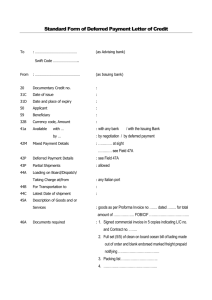
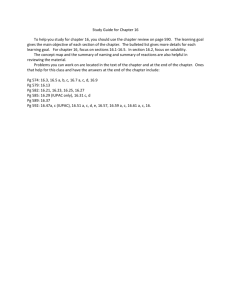
![First Observation of B[over-bar][subscript s][superscript 0]-->D[subscript s][superscript ±]K[superscript ] and](http://s2.studylib.net/store/data/012097029_1-f405f6f39639d76f6431ecbb2431142d-300x300.png)
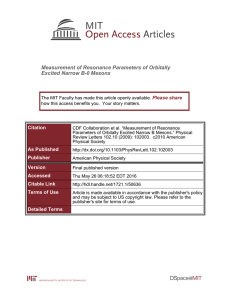
![Search for High-Mass e+e- Resonances in pp-bar Collisions at sqrt[s]=1.96 TeV](http://s2.studylib.net/store/data/012099594_1-3d3697a57081d795bb2905505b74eae7-300x300.png)


